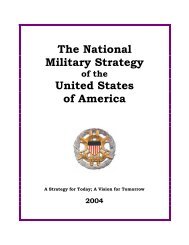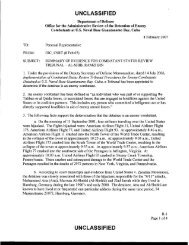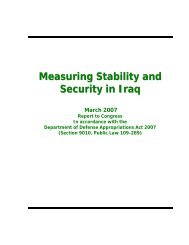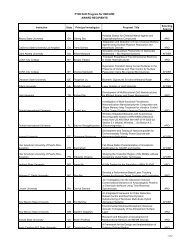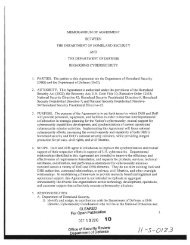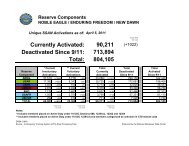Report - United States Department of Defense
Report - United States Department of Defense
Report - United States Department of Defense
You also want an ePaper? Increase the reach of your titles
YUMPU automatically turns print PDFs into web optimized ePapers that Google loves.
UNCLASSIFIED<br />
Additionally, DABS, has executed all urgent transformer installation upgrades in the Kandahar<br />
City distribution system. In July 2012, USACE awarded the contract for replacing and updating<br />
the 110 kV line from the Kajaki substation to Durai Junction with Afghanistan Infrastructure<br />
Fund (AIF) funding. The 110 kV line from Durai Junction to Kandahar was awarded in<br />
September 2012 under the PTEC. As mentioned above, PTEC will strengthen the NEPS and<br />
extend it into the south, to the SEPS. Additionally, USAID’s PTEC project will also focus on<br />
significant technical and managerial capacity building activities with DABS, and on<br />
commercialization <strong>of</strong> the utility system. The scopes <strong>of</strong> work for these activities have been in<br />
development in recent months and will be awarded on-budget through DABS in late 2012.<br />
DABS has already issued tenders for commercialization and transmission line construction under<br />
the PTEC. USAID has received $101M in AIF funding for the first section <strong>of</strong> the connector<br />
from Kabul to Ghazni. USAID will fund the remaining segments with Economic Support Funds<br />
(ESF) funds.<br />
The Salma Dam in Herat Province has overcome persistent security and contractual issues and<br />
work is proceeding, although the dam, a 42-megawatt (MW) power plant and transmission line<br />
to Herat, remains significantly behind schedule. The project is not likely to be completed until<br />
2014.<br />
Civil Aviation<br />
The aviation capability within Afghanistan remains weak, with only limited progress made to<br />
date. The Civil Aviation Law passed Parliament in late 2012 and was published in January 2013.<br />
This law enables the establishment <strong>of</strong> a Civil Aviation Authority (CAA) as an independent<br />
agency reporting through the Ministry <strong>of</strong> Transport and Civil Aviation (MoTCA). This ministry<br />
has not yet finalized the organizational structure and administrative processes for the<br />
establishment <strong>of</strong> the CAA.<br />
Donor nations continue to provide support through the Donor Coordination Board, while<br />
aviation-derived revenues are paid directly into the general fund <strong>of</strong> the Afghan government.<br />
Direct international support continues to be provided to Kabul, Kandahar, Herat, and Mazar-e-<br />
Sharif airfields. Training for aviation services, including air traffic, airfield management, and<br />
fire support, is conducted both internally and externally to Afghanistan for Afghan personnel at<br />
Kabul and Mazar-e-Sharif. Despite the increased training and capacity <strong>of</strong> airspace coordination<br />
and control, transition <strong>of</strong> the Civil Aviation System operation and management directly to<br />
MoTCA will not be possible by the end <strong>of</strong> 2014 due to the lack <strong>of</strong> qualified Afghan personnel.<br />
KAIA is currently the only airfield with some qualified Afghan personnel (air traffic control and<br />
firefighters), with additional Afghan personnel currently in training. However, by the end <strong>of</strong><br />
2014, there will not be enough qualified Afghan personnel available (even at Kabul) to perform<br />
necessary airport functions. MoTCA will, in order to provide uninterrupted Civil Aviation<br />
System operation, be required to contract for a third party to provide Civil Aviation System<br />
operation and management as well as continued training for Afghan personnel in these areas.<br />
Airfield transition plans have been developed for Afghanistan’s main airfields <strong>of</strong> Kabul,<br />
Kandahar, Herat, and Mazar-E-Sharif. Kabul, however, is currently the only airfield with a fully<br />
165



